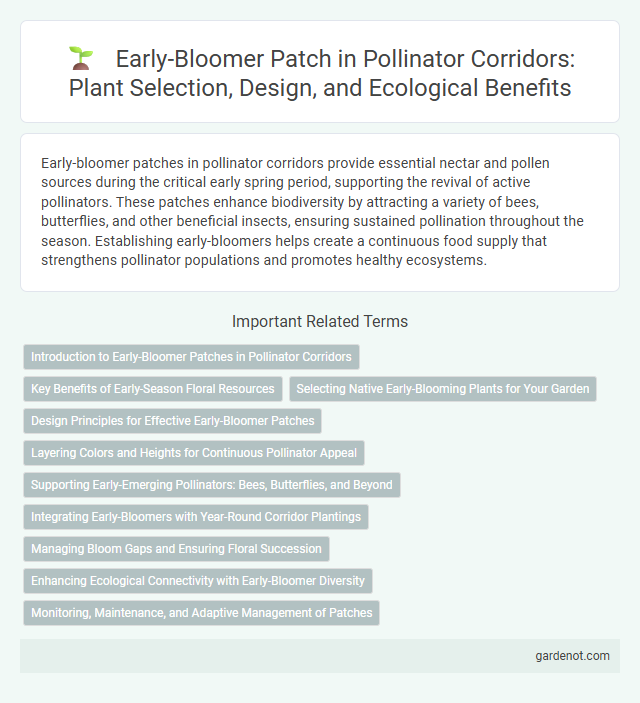Early-bloomer patches in pollinator corridors provide essential nectar and pollen sources during the critical early spring period, supporting the revival of active pollinators. These patches enhance biodiversity by attracting a variety of bees, butterflies, and other beneficial insects, ensuring sustained pollination throughout the season. Establishing early-bloomers helps create a continuous food supply that strengthens pollinator populations and promotes healthy ecosystems.
Introduction to Early-Bloomer Patches in Pollinator Corridors
Early-bloomer patches serve as critical habitats within pollinator corridors by providing essential nectar and pollen sources during the early spring months when few plants are in bloom. These patches support the survival and reproductive success of early-emerging pollinators such as bumblebees, solitary bees, and butterflies. Incorporating native early-flowering species like crocuses, snowdrops, and willows enhances biodiversity and strengthens ecosystem resilience.
Key Benefits of Early-Season Floral Resources
Early-season floral resources in pollinator corridors provide vital nectar and pollen for emerging pollinators, supporting their survival and reproduction. These early-bloomer patches enhance biodiversity by sustaining native bee populations and other pollinating insects during critical growth periods. Access to diverse, nutrient-rich flowers in early spring boosts ecosystem resilience and promotes effective pollination throughout the growing season.
Selecting Native Early-Blooming Plants for Your Garden
Selecting native early-blooming plants such as bloodroot (Sanguinaria canadensis), spring beauty (Claytonia virginica), and wild columbine (Aquilegia canadensis) supports pollinator corridors by providing critical nectar sources during spring emergence. These species promote local biodiversity by aligning blooming periods with the activity of early-season pollinators like mason bees (Osmia spp.) and bumblebees (Bombus spp.). Incorporating a diverse mix of native perennials tailored to your regional climate enhances habitat connectivity and sustains pollinator populations through the fledgling growing season.
Design Principles for Effective Early-Bloomer Patches
Early-bloomer patches should prioritize native plant species that flower in early spring to provide essential forage for emerging pollinators such as bumblebees and honeybees. Spatial diversity and stratification enhance resource availability, ensuring continuous nectar and pollen supply during critical early season periods. Incorporating soil conditions and minimizing pesticide use supports healthy plant growth and optimizes pollinator visitation rates.
Layering Colors and Heights for Continuous Pollinator Appeal
Early-bloomer patches create a vital foundation for pollinator corridors by layering colors and heights, ensuring a continuous and diverse nectar supply from early spring through late bloom periods. Incorporating varied species such as crocuses, snowdrops, and early tulips allows for staggered flowering times, attracting a wide range of pollinators like bees and butterflies. This strategic layering not only enhances visual appeal but also supports pollinator health by providing consistent foraging opportunities in both urban and rural landscapes.
Supporting Early-Emerging Pollinators: Bees, Butterflies, and Beyond
Early-bloomer patches provide critical nectar and pollen sources for early-emerging pollinators such as bumblebees, mason bees, and monarch butterflies, ensuring their survival during scarce periods. These patches enhance biodiversity by supporting a variety of native wildflowers like crocus, snowdrops, and willow catkins, which bloom in early spring. Establishing early-bloomer pollinator corridors boosts ecosystem resilience and promotes healthy pollination networks essential for agricultural productivity and natural habitats.
Integrating Early-Bloomers with Year-Round Corridor Plantings
Integrating early-bloomers into pollinator corridors ensures vital nectar sources are available during early spring, boosting pollinator survival and biodiversity. These patches, featuring native species like willows, maples, and crocuses, create continuity in floral resources, supporting solitary bees and emerging butterflies. Year-round corridor plantings benefit from early-bloomer integration by maintaining consistent habitat quality and enhancing ecosystem resilience across seasons.
Managing Bloom Gaps and Ensuring Floral Succession
Early-bloomer patches play a critical role in managing bloom gaps by providing essential nectar and pollen sources during the late winter and early spring when few plants flower. Strategic planting of native species like witch hazel, red maples, and snowdrops ensures continuous floral succession, supporting diverse pollinator populations throughout the season. Maintaining this temporal flower availability enhances habitat connectivity within pollinator corridors, promoting ecosystem resilience and pollinator health.
Enhancing Ecological Connectivity with Early-Bloomer Diversity
Early-bloomer patches play a crucial role in enhancing ecological connectivity by providing vital food sources for pollinators emerging in early spring. These patches increase habitat diversity, supporting a range of native bee and butterfly species while promoting gene flow across fragmented landscapes. Strategic planting of early-blooming native flora ensures continuous nectar availability, strengthening ecosystem resilience and biodiversity.
Monitoring, Maintenance, and Adaptive Management of Patches
Monitoring early-bloomer patches involves regular surveys of pollinator activity and floral health to assess ecosystem vitality. Maintenance practices include controlled weeding, soil enrichment, and timely replanting to sustain bloom density and diversity. Adaptive management integrates data-driven adjustments to patch composition and management protocols, enhancing pollinator support and habitat resilience.
Early-bloomer patch Infographic

 gardenot.com
gardenot.com